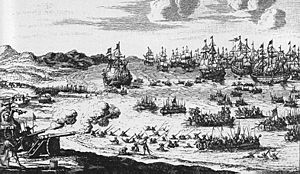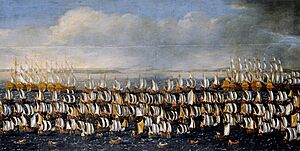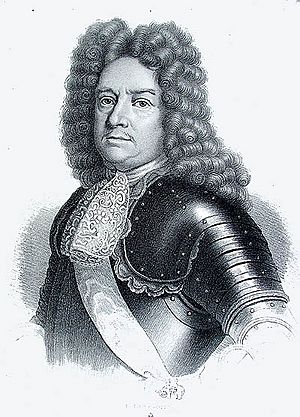Scanian War facts for kids
Quick facts for kids Scanian War |
|||||||||
|---|---|---|---|---|---|---|---|---|---|
| Part of the Franco-Dutch War and the Northern Wars | |||||||||
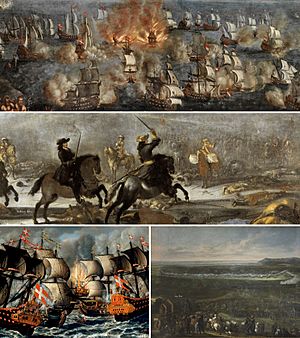 Battles (left to right from top): |
|||||||||
|
|||||||||
| Belligerents | |||||||||
|
|
|||||||||
| Commanders and leaders | |||||||||
The Scanian War was a big conflict that happened between 1675 and 1679. It was part of the larger Northern Wars and the Franco-Dutch War. The main countries involved were Denmark–Norway, Brandenburg (a powerful German state), and Sweden.
Most of the fighting took place in Scania, which is a region in southern Sweden today. Back then, it was a border area between Denmark and Sweden. Battles also happened in northern Germany. Denmark wanted to get back the Scanian lands that Sweden had taken from them earlier.
The war started because Sweden had joined forces with France in a war against several European countries. The Dutch Republic (also known as the United Provinces) was attacked by France. So, the Dutch asked Denmark–Norway for help.
After thinking about it, King Christian V of Denmark decided to invade Scania in 1675. At the same time, Sweden was busy fighting Brandenburg. Denmark's attack on Scania was also supported by a Norwegian attack, known as the Gyldenløve War. This made Sweden fight on two fronts.
At first, Denmark did very well. But the young Swedish King Charles XI of Sweden, who was only 19, led strong counter-attacks. These attacks took back much of what Denmark had gained.
By the end of the war, Sweden's navy had lost many battles at sea. The Danish army was defeated in Scania. However, the Swedes had been beaten in northern Germany by Brandenburg. The war ended when the Dutch, who were Denmark's allies, made peace with France, Sweden's ally. King Charles XI of Sweden also married Danish Princess Ulrike Eleonora of Denmark, who was Christian V's sister.
Peace treaties were signed, and most of the lands lost by Sweden were given back.
Why the War Started
This war had many reasons, mostly about power and money in Europe.
France and Sweden Join Forces
In the 1660s and early 1670s, the Swedish Empire was having money problems. To get financial help, Sweden first joined an alliance against France. But this alliance broke apart.
In 1672, Sweden and France made a deal. France promised to pay Sweden a lot of money if Sweden kept a large army ready in its German lands. France wanted Sweden to attack its enemies from the east. By 1674, Sweden had a big army of over 20,000 soldiers. France threatened to stop paying if Sweden didn't use this army to attack.
Other Countries Form an Alliance
Meanwhile, other countries formed their own alliance against France and Sweden. In 1672, Denmark–Norway, the Holy Roman Emperor Leopold I, Brandenburg, and several German duchies joined together. This alliance had a large army. Brandenburg was a very strong German state at this time, with its own army of 23,000 men.
France had attacked the Netherlands in 1672, a year known as the rampjaar (disaster year). The French King Louis XIV of France wanted to weaken his enemies. He encouraged Sweden to fight Brandenburg. This would keep Brandenburg's army busy and away from France.
Fighting on Land
War in Northern Germany
The war in northern Germany was mainly between Sweden and Brandenburg.
Sweden Against Brandenburg
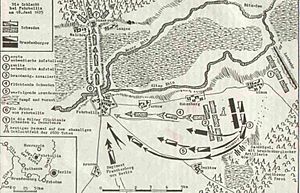
In December 1674, France asked Sweden to invade Brandenburg. The Swedish army moved into a region called the Uckermark. They were getting ready to move west. But Frederick William I, Elector of Brandenburg, quickly brought his army to meet them. On June 28, 1675, the armies met at the Battle of Fehrbellin.
The Battle of Fehrbellin was a small fight, with fewer than 600 soldiers lost on each side. But it was a big defeat for Sweden. It was the first time Swedish forces had lost to a smaller army in a long time. This made Sweden seem vulnerable. Other countries that had been invaded by Sweden before now felt brave enough to join the Scanian War.
When the Dutch asked Denmark for help against France, Danish King Christian V of Denmark wanted to attack Sweden right away. He wanted to get back Scania and Halland. But his adviser, Count Peder Griffenfeld, said no. However, when Sweden lost at Fehrbellin, Christian V saw his chance. He ignored Griffenfeld and attacked.
Allies Take Bremen–Verden

Sweden also had a large army in the duchies of Bremen-Verden in northern Germany. The allies (Denmark–Norway, Brandenburg–Prussia, and others) decided to conquer these areas. They wanted to stop Sweden from getting more soldiers there.
The attack began in September 1675. The allies quickly captured Swedish fortresses. Many Swedish soldiers, who were mostly German, left the army. This was because it was forbidden to fight against states of the Holy Roman Empire.
By the end of 1675, only two Swedish towns, Stade and Carlsburg, were still holding out. Stade finally surrendered in August 1676. This part of the war was not the most important for either side.
Swedish Pomerania Falls
Sweden's power in Germany began to weaken. By 1675, most of Swedish Pomerania and the Duchy of Bremen were taken by Brandenburg, Austria, and Denmark. In December 1677, Brandenburg captured the city of Stettin. Stralsund fell in October 1678. Greifswald, Sweden's last land in Germany, was lost in November.
Denmark Takes Back Scania
Denmark–Norway started to take back Scania, which Sweden had captured in 1658. The attack began when Helsingborg was seized on June 29, 1676. Danish King Christian V of Denmark led 15,000 soldiers against 5,000 Swedish defenders.
At first, the attack was very successful. Many local farmers in Scania helped Denmark. The Swedish troops were outnumbered and not doing well.
Town after town fell to the Danes. The Swedes had to retreat north into Sweden. Within a month, only the strong city of Malmö was still under Swedish control.
The Gyldenløve War
In Norway, the campaigns were called the Gyldenløve War. It was named after Ulrik Frederick Gyldenløve, who was the Governor-General of Norway and led the Norwegian attacks. The Norwegian attacks were usually successful.
1675: A Standstill
While Denmark invaded Scania, Norway's forces gathered along the border. This made Sweden worry about fighting on two fronts. About 4,000 Norwegian soldiers were near Fredrikshald. They protected Norway and threatened to take back Bohuslän, a region that used to belong to Norway.
Swedish General Rutger von Ascheberg had 2,000 men nearby. In 1675, there were mostly small fights along the border. Both armies went into their winter camps in the border areas.
Gyldenløve's 1676 Campaign
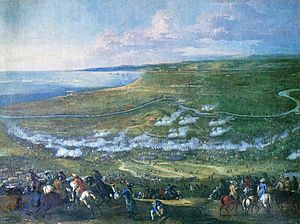
In 1676, Gyldenløve himself led the Norwegian forces. His army captured and fortified a pass at Kvistrum. They then moved south and took Uddevalla easily. Swedish forces fought harder at Vänersborg, but Gyldenløve's army still captured it. From there, his forces moved to Bohus Fortress, where they joined another army of 5,000 men.
In early August, a Danish–Norwegian group was sent north to take Halmstad. They planned to move along the Swedish west coast to meet Gyldenløve's forces. But this led to the Battle of Fyllebro. Here, Charles XI of Sweden won a big victory against the Danish forces. This stopped the two Danish armies from joining up. The Swedes then went north to get more troops. Christian V brought his army to Halmstad and tried to capture the town for a few weeks. But he gave up and went back to Scania for the winter.
Bohuslän Taken Back
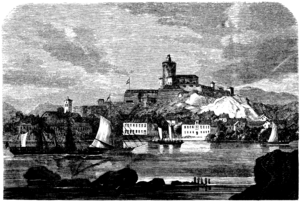
Even though the Danish forces lost at Fyllebro, taking back Scania allowed Norwegian troops to regain Bohuslän, which used to be Norwegian. In the winter of 1677, the Norwegian army grew to 17,000 men. Gyldenløve captured the fortress at Marstrand in July.
The Swedes tried to fight back under Magnus Gabriel De la Gardie. They sent an army of 8,000 to push back the Norwegians. But the Norwegians defeated them. The Swedes were forced to retreat, holding only Bohus Fortress in Bohuslän.
Jämtland Reconquered
In August 1677, Norwegian forces of 2,000 men also took back Jämtland, another region that used to be Norwegian. The people in Bohuslän and Jämtland welcomed the Norwegian forces.
However, things went badly for Denmark–Norway in the Scanian campaigns. The Norwegian forces had to leave when King Christian V ordered them to.
War in Scania Continues
On October 24, 1676, the Swedish King Charles XI of Sweden marched back into Scania with 12,000 soldiers. This put the Danes on the defensive. After several small fights, the Danish army was badly beaten in the Battle of Lund on December 4. Even with Gyldenløve's gains in the north, Charles XI's attack changed the war.
The Danes still held the strong town of Landskrona. They were able to bring in more Dutch and German soldiers. In July 1678, Christian V marched east to help the Danish soldiers in Kristianstad, who were surrounded by the Swedes. After seeing the entire Swedish army, Christian V chose not to fight. He retreated back to Landskrona and took all his troops out of Scania.
War at Sea
The war was also fought on the sea, which was very important for controlling trade and moving troops.
Battle of Öland
In the Battle of Öland on June 1, 1676, the Danish and Dutch fleets won a big victory over the Swedes. They sank one of the largest ships of that time, the Kronan. This victory gave them control of the Baltic Sea.
Battle of Fehmarn
The Danes–Norwegians won another important victory in the Battle of Fehmarn on May 31, 1677. This battle happened near Fehmarn and Warnemünde in northern Germany. The Danes had been blocking a Swedish fleet in Gothenburg. The Swedish ships tried to return to the Baltic Sea but met a larger Danish–Norwegian fleet. The battle lasted from evening until the next morning. It was almost a complete victory for Denmark–Norway. Many Swedish ships were captured, and one was burned.
Battle of Køge Bay
Control of the sea was made sure a year later. The Danish–Norwegian fleet, led by Niels Juel, again defeated the Swedish fleet at the Battle of Køge Bay. This battle was near Copenhagen. The Swedes lost over 3,000 men, while Denmark–Norway only lost about 375. Denmark–Norway's success at sea made it hard for Sweden to move soldiers between northern Germany and Sweden.
Peace Treaties
Peace talks happened between France (representing Sweden) and Denmark–Norway. This led to the Treaty of Fontainebleau on August 23, 1679. France mostly decided the terms of the peace. It said that all land Sweden had lost during the war should be given back. This meant the terms from the Treaty of Copenhagen stayed in place.
The Treaty of Lund was also signed by Denmark–Norway and Sweden themselves. Denmark received a small amount of money from Sweden for war damages and returned Swedish Rügen.
Brandenburg also had to return most of its gains, including Bremen-Verden and Swedish Pomerania, to Sweden. This was part of the Treaty of Saint-Germain-en-Laye.
In Scania, the war had a sad effect on the local people who supported Denmark, known as Snapphane. They had hoped for Danish rule to return. But after Sweden took back control, these people faced harsh treatment from the Swedish authorities.
See also
- dominium maris baltici


